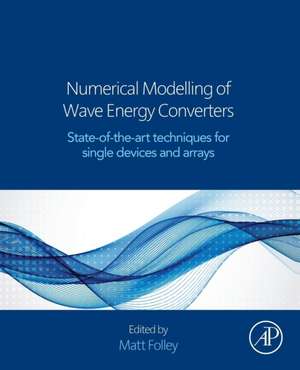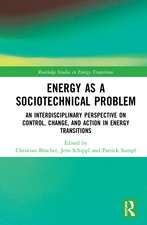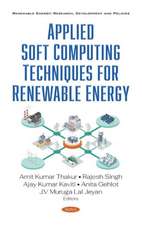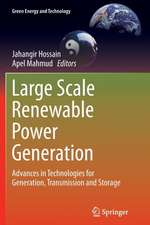Numerical Modelling of Wave Energy Converters: State-of-the-Art Techniques for Single Devices and Arrays
Editat de Matt Folleyen Limba Engleză Paperback – 13 iun 2016
Each chapter starts by defining the fundamental principles underlying the numerical modelling technique and finishes with a discussion of the technique’s limitations and a summary of the main points in the chapter. The contents of the chapters are not limited to a description of the mathematics, but also include details and discussion of the current available tools, examples available in the literature, and verification, validation, and computational requirements. In this way, the key points of each modelling technique can be identified without having to get deeply involved in the mathematical representation that is at the core of each chapter.
The book is separated into four parts. The first two parts deal with modelling single wave energy converters; the third part considers the modelling of arrays; and the final part looks at the application of the different modelling techniques to the four most common uses of numerical models. It is ideal for graduate engineers and scientists interested in numerical modelling of wave energy converters, and decision-makers who must review different modelling techniques and assess their suitability and output.
- Consolidates in one volume information and techniques for the numerical modelling of wave energy converters and converter arrays, which has, up until now, been spread around multiple academic journals and conference proceedings making it difficult to access
- Presents a comparative review of the different numerical modelling techniques applied to wave energy converters, discussing their limitations, current available tools, examples, and verification, validation, and computational requirements
- Includes practical examples and simulations available for download at the book’s companion website
- Identifies key points of each modelling technique without getting deeply involved in the mathematical representation
Preț: 644.47 lei
Preț vechi: 708.20 lei
-9% Nou
Puncte Express: 967
Preț estimativ în valută:
123.33€ • 133.92$ • 103.60£
123.33€ • 133.92$ • 103.60£
Carte tipărită la comandă
Livrare economică 15-29 aprilie
Preluare comenzi: 021 569.72.76
Specificații
ISBN-13: 9780128032107
ISBN-10: 0128032103
Pagini: 306
Dimensiuni: 191 x 235 x 18 mm
Greutate: 0.61 kg
Editura: ELSEVIER SCIENCE
ISBN-10: 0128032103
Pagini: 306
Dimensiuni: 191 x 235 x 18 mm
Greutate: 0.61 kg
Editura: ELSEVIER SCIENCE
Cuprins
1. Introduction
I - WAVE ENERGY CONVERTER MODELLING TECHNIQUES BASED ON LINEAR HYDRODYNAMIC THEORY
2. Frequency-Domain Models
3. Time-Domain Models
4. Spectral-Domain Models
II - OTHER WAVE ENERGY CONVERTER MODELLING TECHNIQUES
5. Nonlinear Potential Flow Models
6. Computational Fluid Dynamics (CFD) Models
7. Identifying Models Using Recorded Data
III - WAVE ENERGY CONVERTER ARRAY MODELLING TECHNIQUES
8. Conventional Multiple Degree-of-Freedom Array Models
9. Semi-analytical Array Models
10. Phase-Resolving Wave Propagation Array Models
11. Phase-Averaging Wave Propagation Array Models
IV - APPLICATIONS FOR WAVE ENERGY CONVERTER MODELS
12. Control Optimisation and Parametric Design
13. Determining Mean Annual Energy Production
14. Determining Structural and Hydrodynamic Loads
15. Environmental Impact Assessment
I - WAVE ENERGY CONVERTER MODELLING TECHNIQUES BASED ON LINEAR HYDRODYNAMIC THEORY
2. Frequency-Domain Models
3. Time-Domain Models
4. Spectral-Domain Models
II - OTHER WAVE ENERGY CONVERTER MODELLING TECHNIQUES
5. Nonlinear Potential Flow Models
6. Computational Fluid Dynamics (CFD) Models
7. Identifying Models Using Recorded Data
III - WAVE ENERGY CONVERTER ARRAY MODELLING TECHNIQUES
8. Conventional Multiple Degree-of-Freedom Array Models
9. Semi-analytical Array Models
10. Phase-Resolving Wave Propagation Array Models
11. Phase-Averaging Wave Propagation Array Models
IV - APPLICATIONS FOR WAVE ENERGY CONVERTER MODELS
12. Control Optimisation and Parametric Design
13. Determining Mean Annual Energy Production
14. Determining Structural and Hydrodynamic Loads
15. Environmental Impact Assessment
























